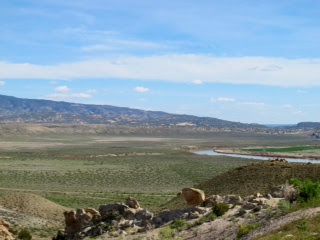 |
| A life-sized Stegosaurus takes up the equivalent of three parking spaces in front of the Dinosaur National Monument Visitor Center. |
Written by Karen.
The topography is starting to change as we drive through Utah. There are still sage green tufts that line the road and grow as far as the eye can see, but the sandy tans of the ground and mountains have changed into warm reddish hues. I consider changing my mind as to whether our next house should have a palette of sage green and tans or the complimentary combination of sage green and rust. Or perhaps include them all into a natural earthy palette of sage green, tans and rust?
There are many more hills, peaks and valleys as we meander through the two-lane highway curves of Utah. We still have the roadways mostly to ourselves, and driving is a pleasure because of that. We don't worry whether we are slowing someone down as we putt up 8% grades, as whenever we look in our rear view mirror there is no one there.
It is hot. You can see the heat in waves as you look into the distance. The heat looks like water shimmering ahead on the road. But it is a mirage. We have had several dust devils hit Chinook fairly hard. We had a split-second notice one time; the other times we grasp the steering wheel tightly as we pass through the vertical whirlwind and wind gusts before the dust devils skitter along.
We pull into the Dinosaur National Monument in the middle of the afternoon. We are still early in the season and can stand on the edge of cliffs and be alone. The sun-baked canyons that surround us whisper of long-held secrets of dinosaurs and other ancient creatures that roamed through this part of the world in times past. The heat, dust, shrubs, wildflowers and rocks touch and tickle my senses. The sight of warped, tilted, banded, and sculptural cliffs, mountains and hilltops in an array of purples, browns, grays, reds, and vanilla visually describe the dramatic and erosive effects of wind, water and time.
One of the highlights of this 210,000+ acre Dinosaur National Monument is the Quarry Exhibit Hall, where a major excavation of large dinosaur fossils is on display. The preserved hillside - or 'The Wall of Bones' as it is called - has a multitude of partially excavated and jumbled dinosaur fossilized bones, as if someone had played the game of pick up sticks many years ago, leaving the bones in partial relief against the variegated colors and stripes of their sandstone tomb. It is 80 feet long and approximately 40 feet high.
According to the interpretive center, this massive gravesite has yielded over 500 remains of large dinosaurs and other animals that lived during the Jurassic time period some 149 million years ago. When flooding occurred in the nearby Green and Yampa rivers, the remains of the larger animals caused a log jam of sorts, creating the unique exhibit of jumbled fossilized bones that are on display today. It is thought by current researchers and paleontologists that there are many more dinosaur fossils still lying untouched in the surrounding hills.
I wander about the two-story interpretive center, reading about these mammoth creatures, wondering what life might have been like so long ago, and tracing my fingertips along the marks and crevices of the ancient bones. How cool is it that you can touch something that is millions of years old!
 |
| Getting close to the Dinosaur National Monument. The Visitor Center is to the left of the picture. The hills behind the green are where a multitude of dinosaur fossils lie. |
 |
| The 'Wall of Bones' is a sloped 80 foot long excavation/grave site with fossilized dinosaur bones scattered throughout. |
 |
| For some perspective on the size of these dinosaur bones, this portion of the thigh bone is taller than I am! |
 |
| A look at the mountain being fragmented over time |
 |
| A look across the Dinosaur National Monument with the Green River flowing gently across the valley. |
 |
| The following two pictures show the surrounding sandstone mountains outside of the 'Wall of Bones' and where it is thought that many more dinosaur fossilized bones lay. |
 |
| Split Mountain. So named because the Green River has split the mountain in half with time, erosion, water and wind. This picture also illustrates what the National Monument calls "Tilted Rocks". |
 |
| Looking back at Chinook from up the mountain where we looked at ancient caves, pictographs and petroglyphs. |








3 comments:
wow I have never been their..places you have gone I think I would like to see..great reporting
Karen, thanks for sharing the great photos of an area I've always been curious to visit. Your word choices are fabulous!
"The sun-baked canyons...whisper of long-held secrets...." "...heat, dust, shrubs, wildflowers and rocks touch and tickle my senses." I'm right there beside you.
Thanks Joanne!
Thanks for coming along for the ride!
Karen.
Post a Comment